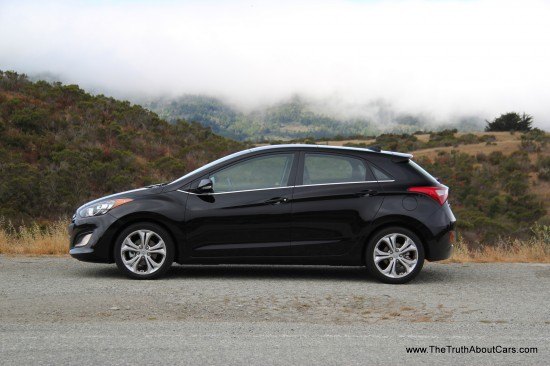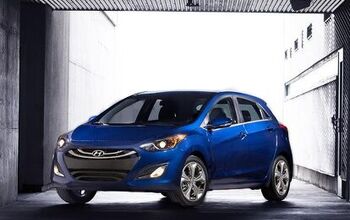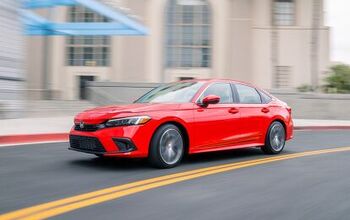Review: 2013 Hyundai Elantra GT (Video)

By pure happenstance I ended up with an Elantra GT immediately after r eviewing the 2014 Kia Forte sedan. As I said last week in the Forte review, the Elantra and Forte are related, but this isn’t a case of Korean badge engineering. It’s far more complicated. The Forte is the new kid on the block while the Elantra has been around for a few years. At this stage in life, Hyundai is trying to inject vitality into the Elantra name by adding new models. First we got the four-door sedan, then a two-door coupé followed by the Veloster which is just a four-door hatchback Elantra (yes, I know Hyundai calls it a three-door, but I know better). If you’re confused by door counts, the new Elantra GT is a five-door. Say what?
About “them doors.” We all know a sedan is a four-door because a trunk isn’t a door. (Despite our exclusive Trunk Comfort Index testing.) Likewise we call the Elantra Coupe a two-door but toss a hatch into the mix and, hey-presto, your cargo portal is a door. How does the Veloster fit in? It has three regular doors (two on one side, one on the other) and a hatch. Thankfully Hyundai killed off the awkward looking Elantra Touring wagon leaving nothing to go head to head with the Mazda3 hatch, Focus hatch and Golf. That’s where the GT fits in.
Exterior
Adding the GT to the lineup puts Hyundai in the unusual position of having more variants of their compact vehicle than any other brand in the USA, and that’s even if you don’t count the Veloster as an Elantra. Part of this is to give customers options the other brands don’t, but it is also to extend the life of the aging Elantra. In 2010 when the Elantra splashed on the scene it was new and exciting, but this is a fiercely competitive segment. In the past three years, the Civic, Forte, Golf and Mazda3 have all been redesigned bringing new and exciting shapes to choose from. In this light the Elantra’s front end is starting to look a old to my eyes, especially when you park it next to the aggressive new Forte. Speaking of that elephant in the room, that 2014 Forte 5-door looks all kinds of hot.
Park the GT next to an Elantra sedan and you’ll notice this isn’t a sedan with a hatch glued on. Instead, the GT rides on a 2-inch shorter wheelbase shared with the Veloster. Along with the reduced wheelbase, Hyundai sliced nearly 9-inches off this sausage slotting the GT between the Veloster and Elantra sedan in overall size. The shorter dimensions made parking the GT easy in tight urban settings even though the GT retains the Elantra’s 34.8-foot turning circle. Despite the platform nip/tuck the GT is the heaviest Elantra variant at a still svelte (well, relatively speaking) 2,745lbs with the manual transmission.
Interior
I took me a few moments to figure out what was going on with the GT’s interior. At first glance the dashboard and controls are familiar, yet this isn’t the same dashboard the Elantra coupé/sedan, or the Veloster. Gone is the “hourglass” center console in favor of a HVAC controls that are larger and easier to use. Our tester had the optional dual-zone climate control system which rearranges the buttons and adds a large blue-backlit display. Although the steering wheel has simply been tweaked with satin “metal” trim, the rest of the interior trappings are a notch above the Elantra sedan and coupe and, depending on where your fingers brush, a notch above the Veloster as well. This is fortunate because with even the Civic going up-market for 2013, the GT could have left the gates at a disadvantage. Thanks to the plastic upgrades, the GT is firmly “middle of the pack.”
Even though the GT is notably shorter and slightly taller than the sedan, folks up front won’t notice much difference. The seats are still supportive and comfortable, but not as easy on the back as the 2013 Civic. You might think the wheelbase reduction would play havoc with rear accommodations but the back seats have slightly more room than in the sedan. Some of that room is thanks to rear seats with a more upright and comfortable profile and some of it comes at the expense of the front seats which get a one inch reduction in travel for GT duty. Getting in and out of those rear seats is easy thanks to large and fairly square door openings. With 23 cubic feet of widget space behind the rear seats and 51 with the rear seats folded, the GT is the most practical Elantra since the dowdy Elantra Touring was mercy killed.
Infotainment
The GT may be new for 2013, but the technology is a few years old. Base shoppers may not mind the lack of progress because the standard 6-speaker audio system is one of the best standard audio systems in this segment. The 170 watt system comes with standard AM/FM/XM radio, a single-slot CD/MP3 player, Bluetooth speakerphone and USB/iPod integration. Sadly you won’t find SYNC-like voice command of your tunes or Pandora streaming, but the system has a natural sound and is easy to use.
High-rollers (like me) won’t be able to live without a touchscreen nav unit, but I was disappointed to find the GT doesn’t get the new 8-inch BlueLink system from the Santa Fe. Instead we find the 7-inch “last generation” system found in the regular Elantra. It’s not that the system is objectionable, it just lacks the snazzy new voice commands and smartphone integration ability you find in other Hyundai products. That new Kia Forte hatchback keeps popping in my mind because the 2014 Forte models get the latest Hyundai/Kia infotainment software with smartphone apps, 911 crash notification, vehicle diagnostics and full voice commands for your music library.
Drivetrain
Under the GT’s short hood beats the same 1.8L four-cylinder engine as the Elantra sedan. Unfortunately this mill doesn’t get Hyundai’s direct-injection sauce so power is rated at a middling 148 ponies and 131 lb-ft. In an interesting twist Hyundai allows you to select the 6-speed manual or the 6-speed automatic regardless of your trim level. This puts the Elantra a cog ahead of the Civic and a few other competitors. When you factor the additional weight of the GT model over the sedan it’s obvious performance is muted. When weight goes up, fuel economy goes down and so it is with the GT. The Elantra sedan scores a respectable 28/38/32 MPG (City/Highway/Combined) with the manual or automatic while the GT drops to 26/37/30 with the manual and 27/37/30 with the automatic. Our real world economy ended up a few steps lower at 28.2 MPG overall, notably lower than the Elantra sedan’s 32.1 MPG score last time I had one.
I spent most of the week inside the 6-speed automatic GT but I was able to hop in a manual equipped version for a few hours because I was intrigued by Hyundai’s decision to sell a row-your-own option on all trims. The automatic is obviously going to be the most popular option and will suit most drivers just fine. Hyundai has continually improved the feel of their slushbox and is now among the best in terms of shift feel and programming. While I like the feel of this 6-speed over Nissan’s CVT, 131 lb-ft would more easily motivate 2,800lbs if it was routed via a CVT. Just sayin… The 6-speed manual still lacks the refinement you’ll find in the VW Golf and the clutch feel is a notch below the Focus that’s a moot point if you want all the tech gadgets and a manual transmission in the same hatch. This is your only option.
Drive
The manual transmission is worth noting because the Elantra GT is much more of a driver’s car than any other Elantra, including the coupé. This is primarily because Hyundai significantly improved torsional rigidity when compared to its platform mates. Also tweaked were the springs and dampers for a tighter and more composed ride than its siblings. The changes are noticeable and make the sedan feel like a damp noodle in comparison. Hyundai seems to have found the right balance between sporty and soft when it comes to the ride with the GT feeling neither jarring nor marshmallowy soft. If road holding manners matter the most, the GT slots below certain Ford Focus models and VW’s Golf. On the rubber front we get 205/55R16 tires standard and an optional upgrade to 215/45R17s (as our tester was equipped) to improve grip. The larger rubber is part of the $950 “touch-and-go” package which nets you keyless-go, the larger wheels, aluminum pedals and a leather wrapped wheel and shift knob. Out on my favorite mountain highway the GT was a team player with more grip and composure than I expected. The steering? That’s another matter.
The Elantra GT gets Hyundai’s latest personalization option: adjustable steering assist. By pressing a button on the steering wheel you can select from three different steering effort settings on the fly. Yes, even mid-apex. Let’s get one thing clear: none of the modes will do anything to improve steering feel. In Comfort mode the GT is hopelessly over-boosted at speed but oddly doesn’t make give you feather-light steering in the parking lot. When in this mode it is all too easy to crank the wheel too far in a corner and end up constantly re-adjusting. Normal is a hair better. Sport is lifeless but firm. I spent my week in Sport.
I notice most reviews of the GT bemoan the “unusually loud” backup camera that pops out of the Hyundai logo on the trunk lid. Bucking the trend I don’t see a problem with this given the GT’s price tag of $18,545-$25,440. Similarly equipped the Ford Focus 5-door lands $1,800 more expensive and the VW Golf is $3,000lbs dearer. If however you factor in the Focus and Golf’s more powerful engines and better road manners, I’d call that difference much smaller. The smaller the delta becomes, the harder it is for me to look past the small things about the Elantra GT that bothered me during the week like the older infotainment software. If you can look beyond all of that, the 9.05 second 0-60 score is something you have to keep in mind because the Elantra GT is among the slowest hatches we have tested in a while.
Still, the GT is a cheaper option and that speaks to my budget-minded nature. But there are still two problems: the 2014 Kia Forte hatchback and the 2014 Mazda3 hatchback. The Forte’s newer underpinnings, more powerful engine, sexier sheetmetal and snazzier infotainment options are likely to be priced neck-and-neck with the Elantra GT. In addition to all that the Forte is likely to be the more engaging ride on the road based on our time with the Forte sedan. Then there’s that new Mazda3 with a two-engine lineup, available iLoop “almost hybrid” system, class leading 30/40MPG rating and a Mazda reputation for excellent road manners. Yes, those cars are still a few months off, but that just means the Elantra GT in the unfortunate position of being a value leader for a limited time only. What could Hyundai do to fix it? If they could jam their 270HP 2.0L turbo under the hood at a reasonable price…
Hyundai provided the vehicle, insurance and one tank of gas for this review.
Specifications as tested
0-30: 3.06 Seconds
0-60: 9.05 Seconds
1/4 Mile: 16.84 Seconds @ 81.7 MPH
Average Observed Fuel Economy: 28.2 over 549 miles

More by Alex L. Dykes
Latest Car Reviews
Read moreLatest Product Reviews
Read moreRecent Comments
- SCE to AUX All that lift makes for an easy rollover of your $70k truck.
- SCE to AUX My son cross-shopped the RAV4 and Model Y, then bought the Y. To their surprise, they hated the RAV4.
- SCE to AUX I'm already driving the cheap EV (19 Ioniq EV).$30k MSRP in late 2018, $23k after subsidy at lease (no tax hassle)$549/year insurance$40 in electricity to drive 1000 miles/month66k miles, no range lossAffordable 16" tiresVirtually no maintenance expensesHyundai (for example) has dramatically cut prices on their EVs, so you can get a 361-mile Ioniq 6 in the high 30s right now.But ask me if I'd go to the Subaru brand if one was affordable, and the answer is no.
- David Murilee Martin, These Toyota Vans were absolute garbage. As the labor even basic service cost 400% as much as servicing a VW Vanagon or American minivan. A skilled Toyota tech would take about 2.5 hours just to change the air cleaner. Also they also broke often, as they overheated and warped the engine and boiled the automatic transmission...
- Marcr My wife and I mostly work from home (or use public transit), the kid is grown, and we no longer do road trips of more than 150 miles or so. Our one car mostly gets used for local errands and the occasional airport pickup. The first non-Tesla, non-Mini, non-Fiat, non-Kia/Hyundai, non-GM (I do have my biases) small fun-to-drive hatchback EV with 200+ mile range, instrument display behind the wheel where it belongs and actual knobs for oft-used functions for under $35K will get our money. What we really want is a proper 21st century equivalent of the original Honda Civic. The Volvo EX30 is close and may end up being the compromise choice.



















































Comments
Join the conversation
Oh and I so miss my 2011 Elantra Touring . It ran perfectly and handled perfectly unlike the 2013 POS . Also the gas milage is worse than my 2011 and it has 6 speed automatic . Not one friggin Hyundai model can say it gets good gas mileage . This is the last Hyundai product I will ever buy .
Wow! Some of the negative responses/reviews must be from those who are used to gliding along in top shelf Cadillacs. I feel my Hyundai Elantra GT drives just fine and is comfortable. i bought it as used car and been driving it for 2 years with no problems.